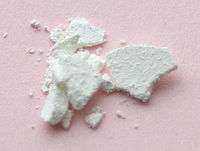Dysprosium(III) oxide
 | |
 | |
| Identifiers | |
|---|---|
| 1308-87-8 | |
| 3D model (Jmol) | Interactive image |
| ChemSpider | 3296880 |
| ECHA InfoCard | 100.013.786 |
| PubChem | 159370 |
| |
| |
| Properties | |
| Dy2O3 | |
| Molar mass | 372.998 g/mol |
| Appearance | White powder. |
| Density | 7.80 g/cm3 |
| Melting point | 2,408 °C (4,366 °F; 2,681 K)[1] |
| Negligible | |
| Structure | |
| Cubic, cI80 | |
| Ia-3, No. 206[2] | |
| Hazards | |
| Main hazards | Non-Toxic |
| Safety data sheet | External MSDS |
| Related compounds | |
| Other anions |
Dysprosium(III) chloride |
| Other cations |
Terbium(III) oxide, Holmium(III) oxide |
| Except where otherwise noted, data are given for materials in their standard state (at 25 °C [77 °F], 100 kPa). | |
| | |
| Infobox references | |
Dysprosium Oxide (Dy2O3) is a white, slightly hygroscopic powder having specialized uses in ceramics, glass, phosphors, lasers and dysprosium metal halide lamps.
It can react with acids to produce the corresponding dysprosium(III) salts:
Dy2O3 + 6 HCl → 2 DyCl3 + 3 H2O
References
- ↑ Webelements Dysprosium trioxide
- ↑ Curzon A.E., Chlebek H.G. (1973). "The observation of face centred cubic Gd, Tb, Dy, Ho, Er and Tm in the form of thin films and their oxidation". J. Phys. F. 3: 1–5. doi:10.1088/0305-4608/3/1/009.
This article is issued from Wikipedia - version of the 6/15/2016. The text is available under the Creative Commons Attribution/Share Alike but additional terms may apply for the media files.